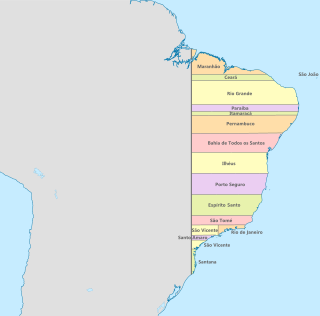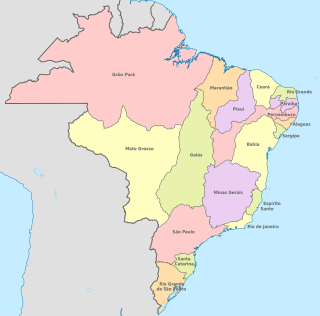
The federative units of Brazil are subnational entities with a certain degree of autonomy and endowed with their own government and constitution, which together form the Federative Republic of Brazil. There are 26 states and one federal district. The states are generally based on historical, conventional borders which have developed over time. The states are divided into municipalities, while the Federal District assumes the competences of both a state and a municipality.

Colonial Brazil comprises the period from 1500, with the arrival of the Portuguese, until 1815, when Brazil was elevated to a kingdom in union with Portugal. During the 300 years of Brazilian colonial history, the main economic activities of the territory were based first on brazilwood extraction, which gave the territory its name; sugar production ; and finally on gold and diamond mining. Slaves, especially those brought from Africa, provided most of the workforce of the Brazilian export economy after a brief initial period of Indigenous slavery to cut brazilwood.

The Viceroyalty of Brazil refers, in narrow scope, to office of viceroy of the Portuguese colonial State of Brazil and, in broad scope, to the whole State of Brazil during the historic period when its governors had the title of "viceroy". The term "viceroyalty" however never officially designated the title of the colony, which continued to be designated "state". Until 1763, the title "Viceroy" was occasionally granted to some governors of Brazil who were members of the high nobility, with the remaining keeping the title "governor-general". From around 1763, the title "viceroy" became permanent, so being granted to all governors. The position of viceroy was abolished, when the Portuguese court transferred to Brazil in 1808, with the State of Brazil becoming directly administered by the Portuguese Government seated in Rio de Janeiro.
A donatary captain was a Portuguese colonial official to whom the Crown granted jurisdiction, rights, and revenues over some colonial territory. The recipients of these grants were called donatários (donataries), because they had been given the grant as a doação (donation) by the king, often as a reward for service.
São Francisco may refer to:

The Captaincy of Pernambuco or New Lusitania was a hereditary land grant and administrative subdivision of northern Portuguese Brazil during the colonial period from the early sixteenth century until Brazilian independence. At the time of the Independence of Brazil, it became a province of United Kingdom of Portugal, Brazil and the Algarves. Captaincies were originally horizontal tracts of land (generally) 50 leagues wide extending from the Atlantic Ocean to the Tordesillas meridian.

The State of Brazil was one of the states of the Portuguese Empire, in the Americas during the period of Colonial Brazil.

The Governorate General of Brazil was a colonial administration of the Portuguese Empire in present-day Brazil. A governorate was equivalent in status to a viceroyalty, though the title viceroy didn't come into use until the early 18th century. They were ruled by a Governor General who reported to the Crown. The Governor General had direct authority over the constituent royal captaincies, and nominal but ill-defined authority over the donatary captaincies. One captaincy, that of Duarte Coelho in Pernambuco, was exempt by royal decree from the authority of the Governors General.

Events in the year 1904 in Brazil.

Events from the year 1894 in Brazil.

Events in the year 1984 in Brazil.

The Royal Captaincy of São Paulo was one of the captaincies of Colonial Brazil. It received this name on December 2, 1720, when John V of Portugal created the Captaincy of Minas Gerais from the division of the Captaincy of São Paulo and Minas de Ouro, which had been created in 1709 with the purchase by the Portuguese crown of the Captaincy of São Vicente.

The Captaincy of Paraíba was a Portuguese Empire overseas captaincy in Brazil created in 1574. However, it was only conquered more than a decade later with the supposed extinction of the Captaincy of Itamaracá in the second half of the 18th century, since it was originally part of French America and its fiefdoms, such as Forte Velho and Baía da Traição.

The Captaincy of Rio de Janeiro was formed in the northern portion of the Captaincy of São Vicente, in a territory that extended from Macaé to Caraguatatuba. This part of the Captaincy had been abandoned by its donatário Martim Afonso de Sousa, who was never interested in its settlement and focused his attention and resources on the area of the current São Paulo coast.

The Captaincy of Itanhaém was one of the hereditary captaincies of colonial Brazil.

The Captaincy of Maranhão was one of the administrative subdivisions of the Brazilian territory during the colonial period in Portuguese America. It was created in 1534 along with thirteen other hereditary captaincies and granted by John III, King of Portugal, to the so-called donatários.

The Captaincy of Rio Grande was one of the administrative subdivisions of Brazilian territory during the colonial period of Portuguese America. It was created in 1534 along with thirteen other hereditary captaincies and granted by John III, King of Portugal, to the so-called donatários. Initially, it was administered by João de Barros, a Portuguese historian, and Aires da Cunha.

The history of Paraíba began before the discovery of Brazil, when the coastline of the state's current territory was populated by the Tabajara and Potiguara indigenous peoples. When the Portuguese arrived, the region was established as part of the Captaincy of Itamaracá. However, there were difficulties in implementing the Portuguese occupation fronts in the area, especially due to the resistance of the natives and the influence of French explorers, who used the coast of Paraíba for the illegal extraction of brazilwood.
Proposals for the creation of federative units in Brazil are currently under discussion and in different stages of processing in the National Congress. The creation of 18 new states and three new federal territories were officially proposed, which would bring the total number of federative units to 48. The region with the largest number of federative units would be the North region, while the South region would be the only one with a new federative unit. The states with the most advanced stage of creation are Gurgueia and Maranhão do Sul both in the Northeast region.
















